xDai (STAKE) Review: Helping Ethereum Scale
The xDai Chain was created as the very first U.S. dollar stable blockchain in the world and went live in October 2018. It is meant for transactional payments that are inexpensive, fixed fee, private, and very fast.
It has a dual token model, using a stable-coin called xDai for transactional payments, and a second token called STAKE for consensus based on a new delegated Proof-of-Stake consensus model called POSDAO, which is implemented by a DAO as you might have guessed.
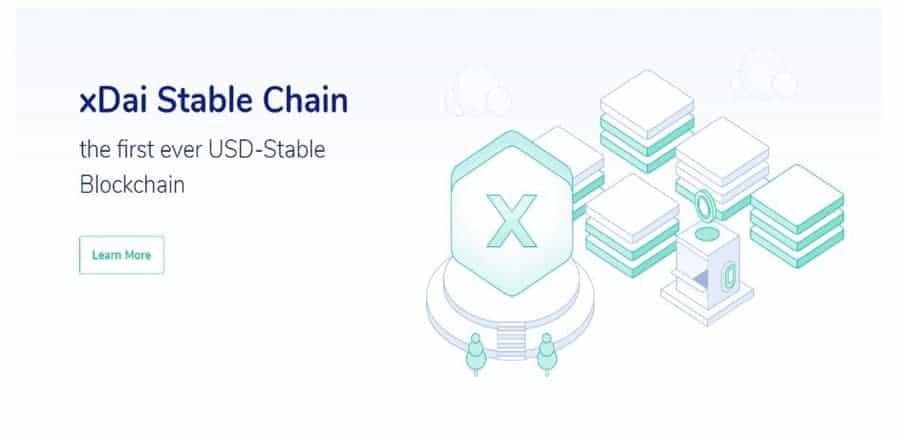
As we said, the xDai Chain is very fast, with block times of just 5 seconds, and the ability to do 70 transactions per second. It has inexpensive fixed fee transactions and will process hundreds of transactions for just $0.01.
Users can even predetermine the cost of transactions because the xDai token is stable. Overall it is one of the best digital assets currently available for transactional payments, but thanks to a multi-chain staking mechanism it has even greater utility.
xDai Multi-Chain Staking
As mentioned already the xDai Chain is built on a dual token model. The two tokens included in this model are:
xDai – This is a stable-coin with its value pegged to the U.S. dollar. The stability of xDai allows for predetermined fees that are extremely low in comparison with many other blockchains. Users benefit from stable balances and stable gas fees, and these features also make the xDai Chain more scalable. Plus, it benefits from the massive $1.9 billion market capitalization of Dai.
STAKE – The STAKE token is the consensus token that is used to secure the network. It is a volatile token with a price determined by the market. It is also used for staking and to provide rewards to network validators.
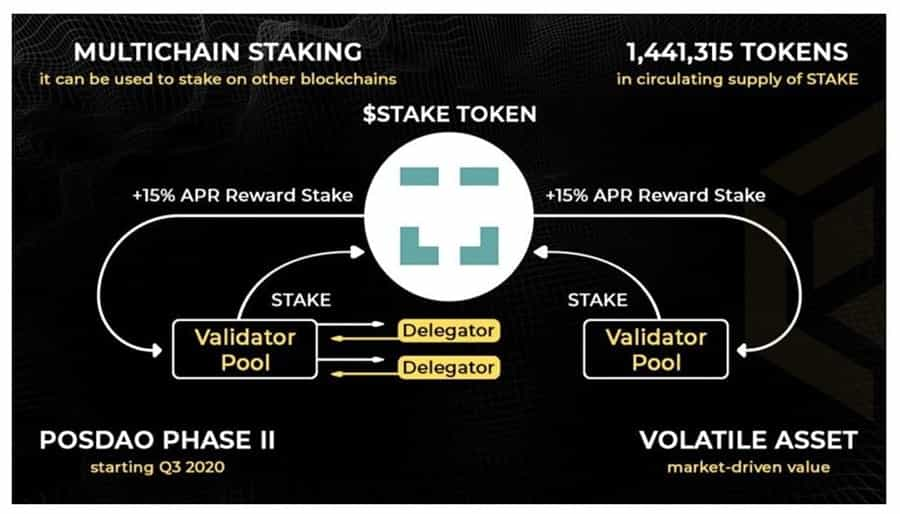
On the xDai Chain there are 3 ways to earn staking rewards. These include the transaction fees that are paid in xDai, the STAKE rewards for validating blocks, and bridge fees. Previously users were also able to earn interest fees in CHAI from locking Dai in the bridge.
However that feature was deprecated in October 2020 by a governance vote due to the savings rate being set to 0 for a prolonged period and because the mechanism was costing users additional fees. It is possible the governors will reintroduce this feature at a later date, or that they will introduce some other form of incentivazation.
Transaction fees are paid in xDai and are sent to the validator who seals the block that contains the transactions. As transaction fees are quite low with the xDai Chain, this is one of the smaller incentives.
The larger primary incentive for becoming a validator are the STAKE rewards that are paid out for validating blocks. The validator rewards are split evenly between the 19 chosen validator nodes, and are currently set at 15% APY, which makes it very attractive to become a validator node.
Bridge rewards are collected whenever funds (either xDai or STAKE) are moved into or out of the chain. An entrance or exit fee may be charged, and this fee is equally distributed to all validator pools in the validator set which are active when the funds are bridged. Fee amounts are customizable through governance decisions and are currently TBD.
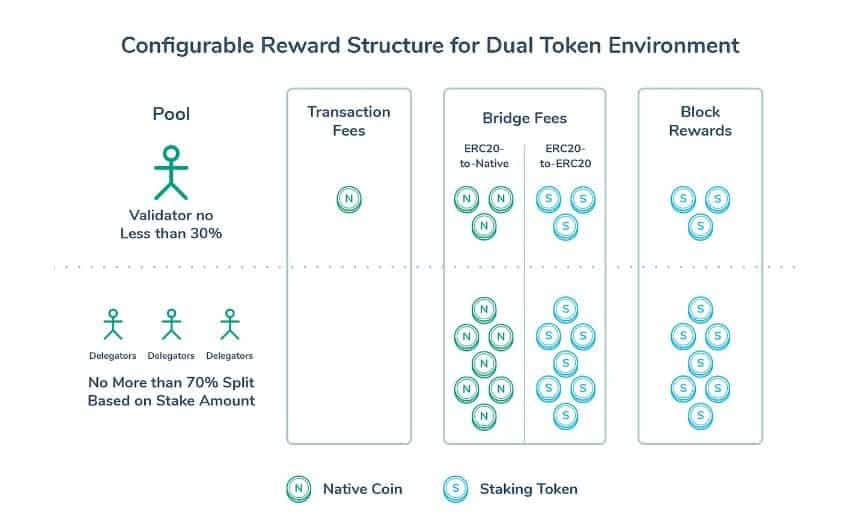
With multi-chain staking available any sidechain under POSDAO is able to use the STAKE token to secure the chain and for validators to earn rewards. This means that STAKE tokens could be staked on other blockchains in the future.
Obviously this is extremely powerful and could create massive value in the STAKE token if there are many sidechains built under the DAO since each of these sidechains would require STAKE to secure them.
POSDAO Consensus Mechanism
The xDai Chain began as a Proof-of-Authority chain, but transitioned to a Delegated Proof-of-Stake mechanism known as POSDAO (Proof of Stake Decentralized Autonomous Organization) on April 1, 2020. This is when the STAKE token was introduced. Phase 1 of the transition created the validator nodes, but didn’t allow for public staking.
Phase 2 was finalized on December 23, 2020 and allowed for public staking, EasyStaking, and reward expansion.
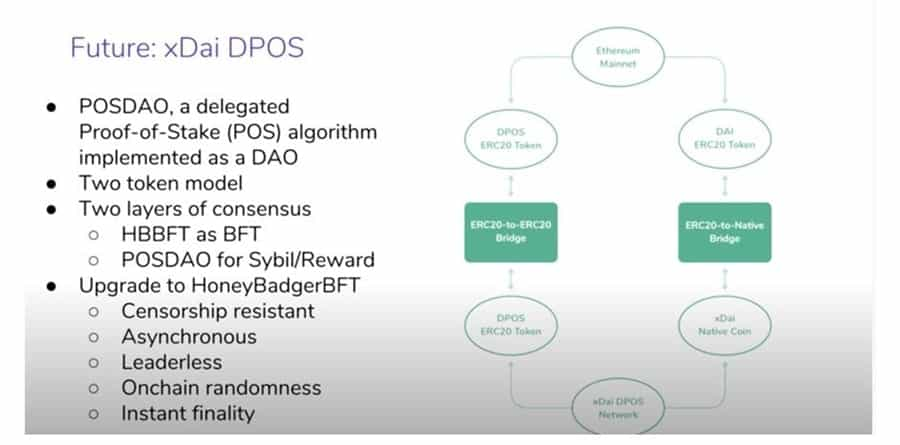
There is one final phase to potentially be completed, which is for HoneyBadger BFT Consensus Layer Integration. The Honey Badger consensus algorithm allows nodes in a distributed, potentially asynchronous environment to achieve agreement on transactions.
The agreement process does not require a leader node, tolerates corrupted nodes, and makes progress in adverse network conditions. Currently there is no timeline for implementation, and while this is being actively developed, the determination to implement it on the xDai Chain will be by the governance process.
xDai SideChains
With the POSDAO consensus mechanism there are an unlimited number of side-chains that can be created and governed. The xDai chain is just the first, and this mechanism will allow for the horizontal scaling of the network.
The DAO is able to configure many of the variables of the side-chains such as the token (or tokens) used, the bridge fees, the block rewards, transaction fees, the number of validators, and more. In this way the network is able to upgrade on-chain. Security is provided by the Ethereum main chain, while the POSDAO consensus mechanism makes xDai Chain efficient, fast, scalable, and inexpensive.
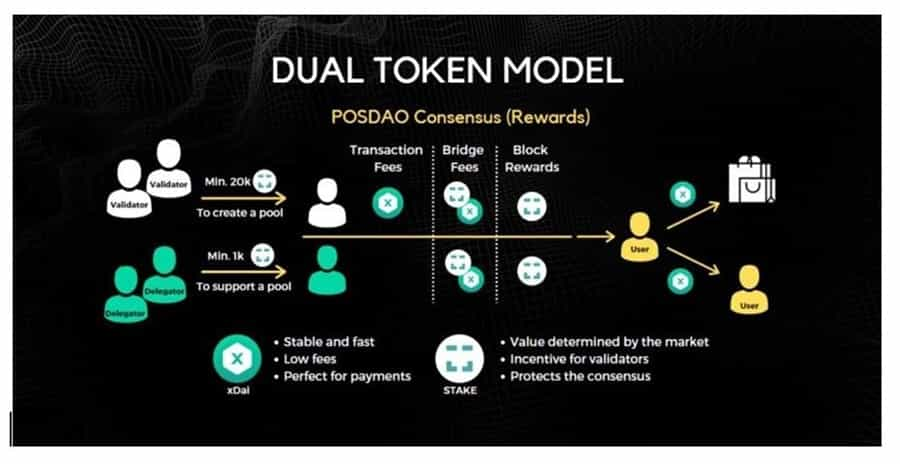
Using side-chains opens up a huge array of use cases. Of course a side-chain could be created to run digital versions of any other fiat currency or cryptocurrency. Any of the following use cases could be implemented on an xDai side-chain:
- Peer-to-Peer Payments -Fast and efficient stable payments are possible with xDai.
- Community Currencies - Providing a blockchain solution to enable local trade and exchange.
- Prediction Markets - Stable prices remove fluctuating transaction fees, allow for more participation.
- Blockchain Games - A more responsive UX, micropayments, and predictable cross-chain interactions are achievable in a stable ecosystem.
- Cryptocurrency for Events & Conferences - Easy onboarding, usage and rewards for event participants (even crypto novices!).
- DAO Governance - On-chain voting and management for Decentralized Autonomous Organizations.
- Digital Voting
- NFT Mint and Transfer
- DeFi (Decentralized Finance)
- B2B & Enterprise Applications
The xDai Chain Team
The idea for xDai Chain came about in 2018 at ETHBerlin. It was created during a discussion among members of the POANetwork team, and the leader of the entire project is POANetwork tech lead Igor Barinov.
Igor is an award-winning blockchain expert with over 16 blockchain and computer programming accolades. He has also been the winner of blockchain hackathons at the Consensus, Texas Bitcoin Conference, BitHack, and Distributed Trade.
With professional certifications in programming and data science as well as deep learning in the design of memory networks, implementation of generative models, design and training segmentation systems and neural translation systems he is well known for pioneering developments in federated blockchains and smart contracts.
Igor Barinov is the tech and operations lead and has been involved with Ethereum based projects for years, inventing novel projects and new mechanisms of consensus.

Additional xDai project team leaders include Vadim Arasev (xDai core developer), Victor Barinov (BlockScout + Nifty Wallet team lead) Alex Kolotov (TokenBridge lead), Max Alekseenko (Decentralized App development) & Andrew Gross (technical writer).
Their experience spans not only blockchain development but each brings a unique perspective from fields such as telecommunications, robotics, e-commerce, informatics, computer science.
Who is POANetwork?
POANetwork is behind the xDai Chain project and many of the tools that support xDai Chain. It is its own autonomous network as well, built on the Ethereum protocol. It uses a Proof-of-Authority consensus mechanism, which makes all of its validators public. Validators are independent and pre-selected using a solid vetting process that ensures a selection of validators with good behavior.
The POANetwork has a strong R&D focus on Ethereum Ecosystem, which has resulted in several meaningful projects being developed since the POANetowrk was launched in 2017. These include a robust open-source explorer called BlockScout, which is now the primary explorer for Ethereum Classic and many other chains.
They also develop and support NiftyWallet, a web3 wallet designed to support alternate chains, and built the TokenBridge, which provides interoperability between different blockchains.
The STAKE Token
The STAKE token is an ERC-677 token that was created when the xDai Chain network was switched over to POSDAO consensus. This is similar to the ERC-20 token, but has extended functionality.
It is a volatile token, with a value determined by market dynamics, and is also used for staking and governance on the xDai Chain blockchain. STAKE is not needed if you simply want to use xDai transactionally. It is needed if you want to create a validator node, or if you’re interested in staking.
The STAKE token did have an ICO in April 2020, with a small number of tokens sold for $0.55 each in an auction at BitMax. Only 400,000, or 4.6% of the token supply was offered for sale, raising $220,000 for the project. Prior to the public auction there were two private sales that had roughly 2 million STAKE sold for $0.355 and $0.40. All of these early investors are no doubt quite happy as the token immediately shot up by 200% and hasn’t looked back since.
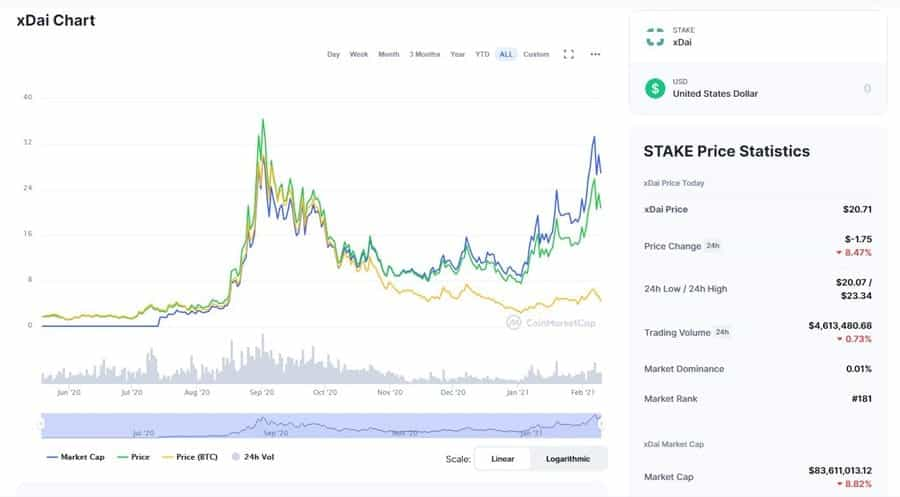
Once the token was actually released it shot up, reaching an all-time high of $36.26 on September 1, 2020. It did drop back from those heights, but never went lower than $7.47 and has been rallying off that level in the first quarter of 2021. As of mid-February 2021 the STAKE token is priced at $20.71.
There are a number of exchanges that list STAKE, but nearly all the volume in this token is on Uniswap and BitMax.
Staking on xDai Chain
There are three ways to stake your STAKE tokens. The first two involve public staking on xDai, either as a validator or a delegator, while the third involved staking on Ethereum using the EasyStake system. The choice over which to use will often come down to the amount of STAKE tokens you have available or the number you wish to stake.
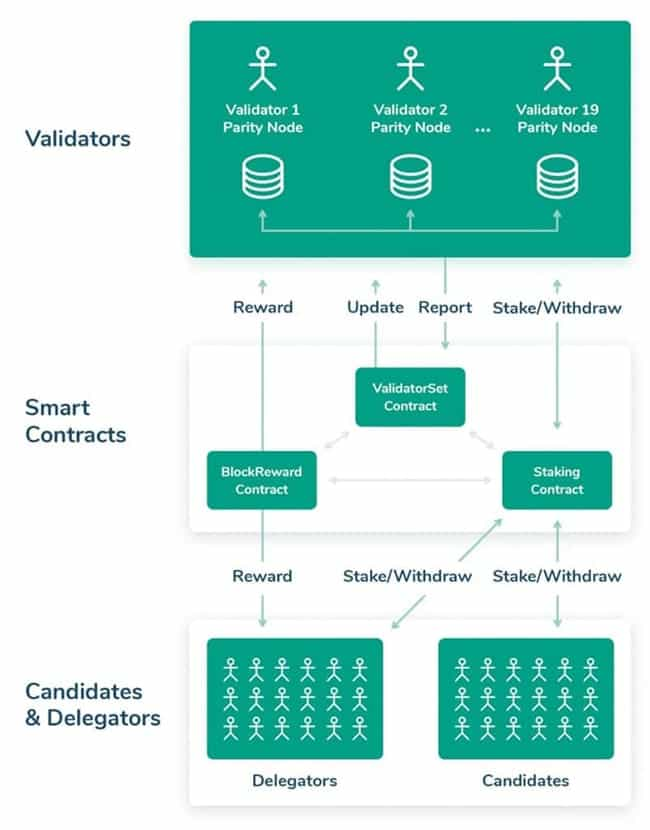
The minimum staking amounts are as follows:
Validators – Minimum 20,000 STAKE
Delegators – Minimum 200 STAKE (this was lowered from 1,000 by a governance vote)
EasyStake – Minimum 0.000000000000000001 STAKE
Note that a small amount of xDai is also required for placing, moving and removing stake.
Becoming a Validator
There are 19 validators who share the staking rewards and once a week a selection is made to determine which nodes will be the validators. In order to become a candidate you need a total of 20,000 STAKE tokens staked.
The determination for which 19 candidates will become validators is based on the total amount of STAKE staked plus a random number generated. Full instructions for becoming a candidate for validating can be found here.
Becoming a Delegator
It’s a large commitment to become a candidate, and many community members will prefer becoming a Delegator instead. The requirement is far less, with just 200 STAKE tokens needed to become a delegator.
Delegators can also split their STAKE between multiple candidates, move their stake from one candidate to another, and remove their stake at any time. The block reward for delegators is based on the amount of stake they have in the pool. You can find complete instructions for becoming a delegator here.
Using EasyStake
If you have less than 200 STAKE then the EasyStake method will be the best way for you to delegate and earn staking rewards. EasyStake can be done by connecting a web3 wallet containing STAKE to the Easy Stake website, or it can be done through BitMax.
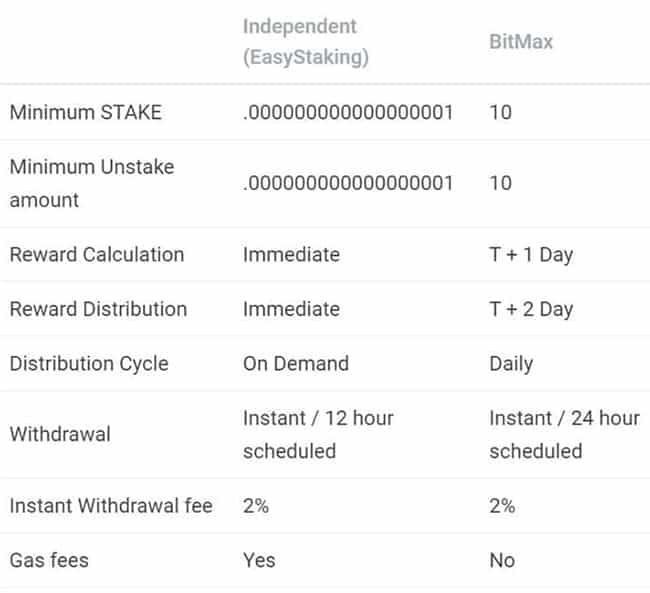
If staking from a web3 wallet there is a minimum staking amount of 0.000000000000000001 STAKE. If staking through BitMax there is a minimum of 10 STAKE required.
The Burner Wallet & xDAI
One thing that any project needs to gain greater adoption is some sort of killer app. The Burner Wallet was that app for xDai. Even though it was created by third-party developer Austin Griffith, it generates massive value for the xDai Chain (as does the updated Burner Wallet 2).
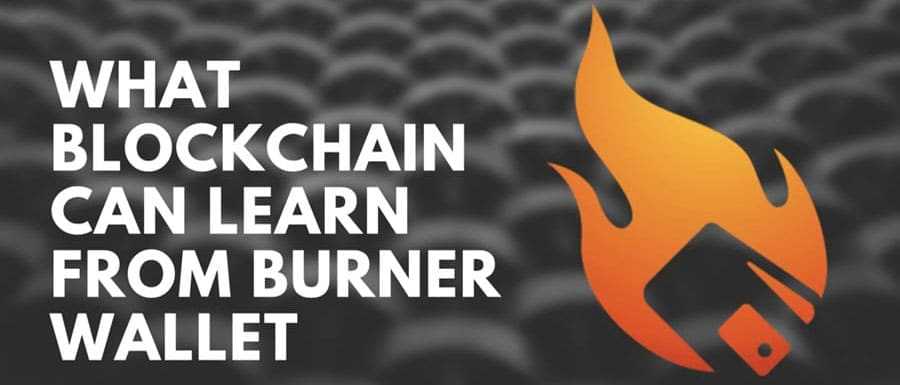
The value of the Burner Wallet was discovered in February 2019, when it was used at ETHDenver by food trucks to accept payments in xDai. The trucks accepted payments for 4,405 meals with a total value of $38,432.56 and yet the total fees paid were just $0.20! That’s a strong statement for using xDai as a transactional payment, but it’s equally strong in promoting the use case for Burner Wallet as a way to easily provide a digital payment system at any large event.
The idea for Burner Wallet came about because of the need for an easy way to carry and exchange small amounts of crypto. Which is why it pairs so well with xDai and its extremely low transaction fees and fast transaction times. And the name “Burner” just reminds you that this is the wallet for crypto you are planning on spending.
The Burner Wallet works in a mobile browser and you can generate one automatically by visiting xDai.io. The private keys are held in the local storage of your device and will remain there whenever you revisit the website. However it is recommended that you empty the wallet regularly and then burn your ephemeral private key using the “Burn PK” function.
The Burner Wallet was created to be analogous with cash. Just like cash you won’t use it to carry much because it can be lost, but also like cash it makes exchanging value incredibly easy. Even those who aren’t steeped in crypto-knowledge can easily use the Burner Wallet. Say you’d like to split the cost of an Uber with your friend. Just shoot their QR code with your smartphone and a new Burner Wallet will automatically open to exchange value with them.
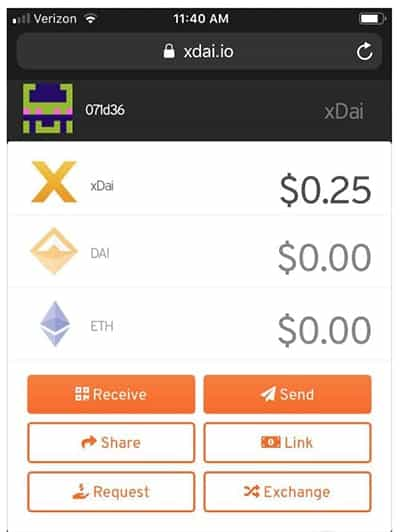
This is not a long-term storage wallet, but the very name will remind you of that anytime you use it. The reason you don’t want to use it for long-term, or for large amounts, is because the private key lives as a browser cookie.
That makes it very insecure. However it is also extremely convenient since there’s no need for you to remember long mnemonics or passphrases. It’s simply a great way to use crypto on a day-to-day basis.
Conclusion
It appears that the side-chains being made possible by xDai are the solution required to drive greater adoption of cryptocurrencies. They will provide greater scalability and privacy, and allow for easy, fast, inexpensive payments.
A stable-coin solution like xDai provides massive liquidity, speed, and predetermined gas prices. That makes xDai an ideal solution for a transactional currency. And having the ability to add side-chains representing any fiat or crypto currencies seems to be huge.
The dual token system is also a benefit to the overall ecosystem, allowing some users to stake and earn for securing the system and providing decentralization, while others simply use the xDai stable-coin for transactions, potentially without even knowing there’s another token that makes the whole ecosystem possible.
There have been some worries that Ethereum 2.0 might overtake the project with lower gas fees and higher transactions per second, but so far that’s not been the case. Plus the stable-coin offered by the xDai Chain project serves a distinct purpose on its own.
It’s known that many people shy away from cryptocurrencies due to their extreme volatility. Most people don’t want to take the chance that the money in their wallet or account will lose 20% of its value overnight.
Stable-coins fix that issue for people, and also give greater scalability, lower fees, and better usability.
The main value propositions for xDai Chain includes lower fees, speed, privacy, income from staking, and the potential for horizontal scaling through the creation of additional side-chains linked to fiat currencies or other cryptocurrencies.
Disclaimer: These are the writer’s opinions and should not be considered investment advice. Readers should do their own research.
